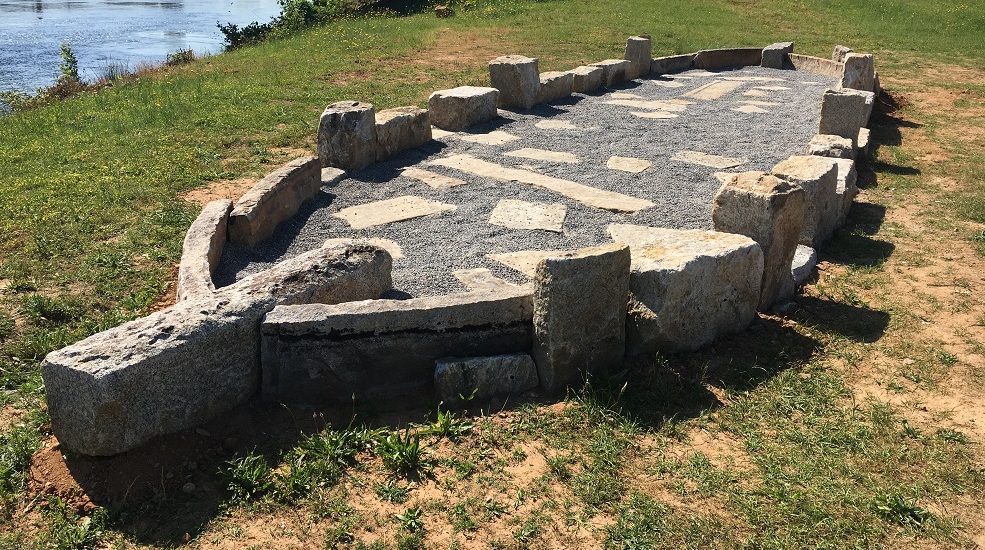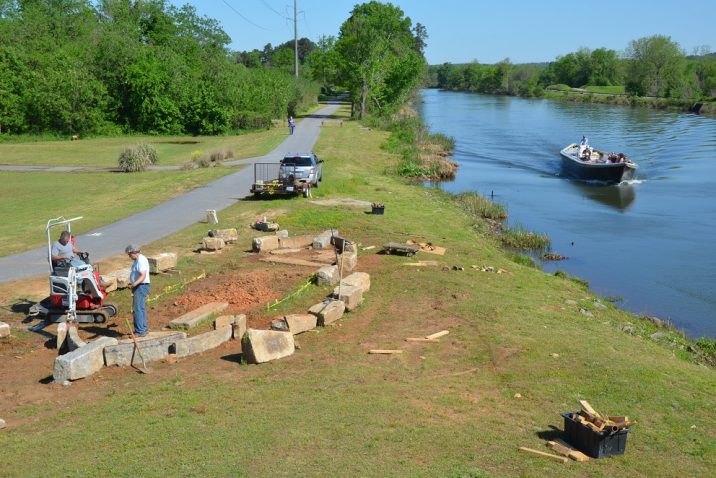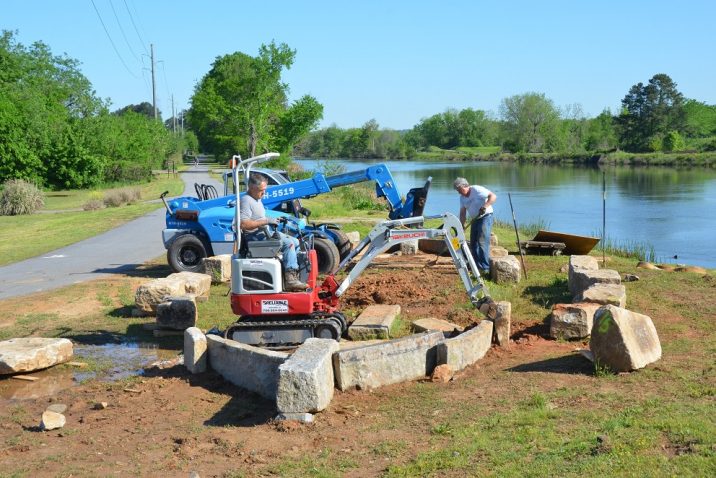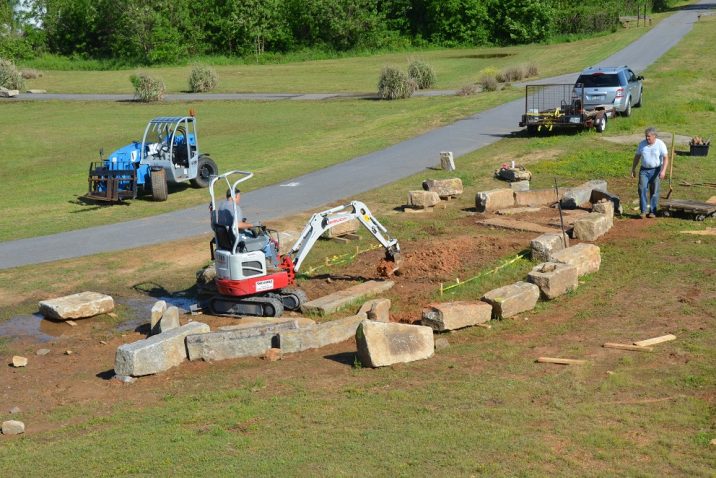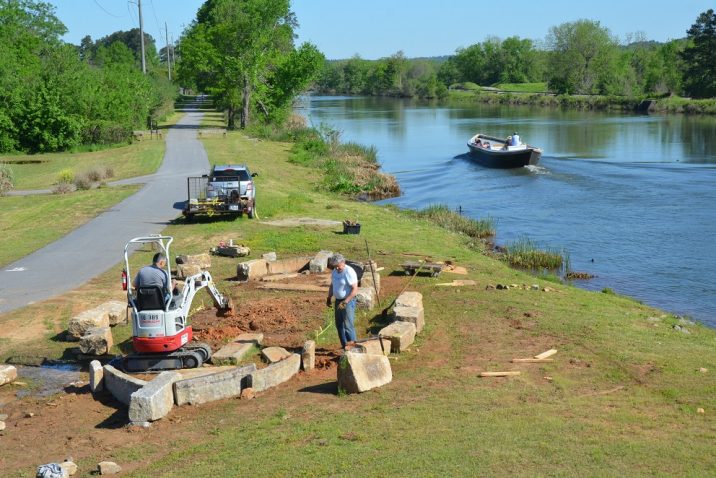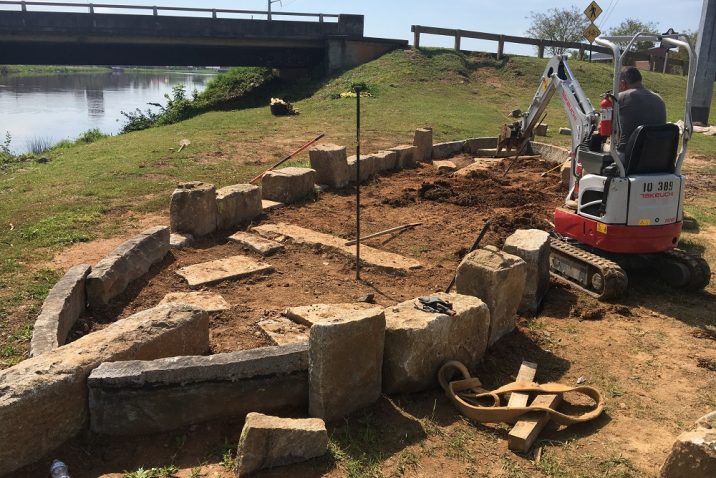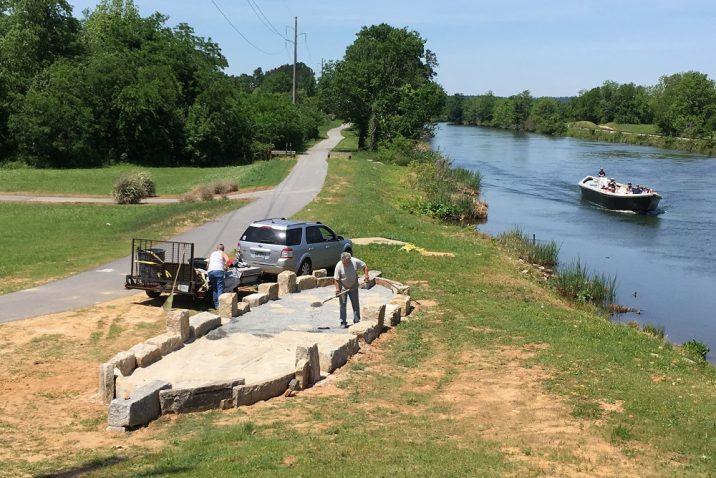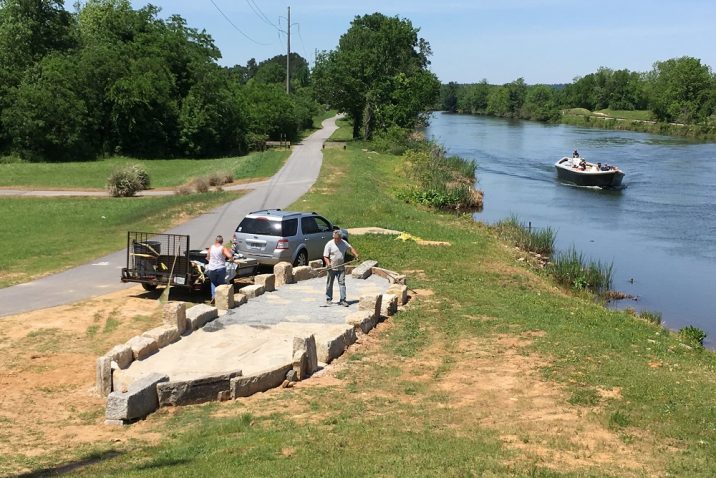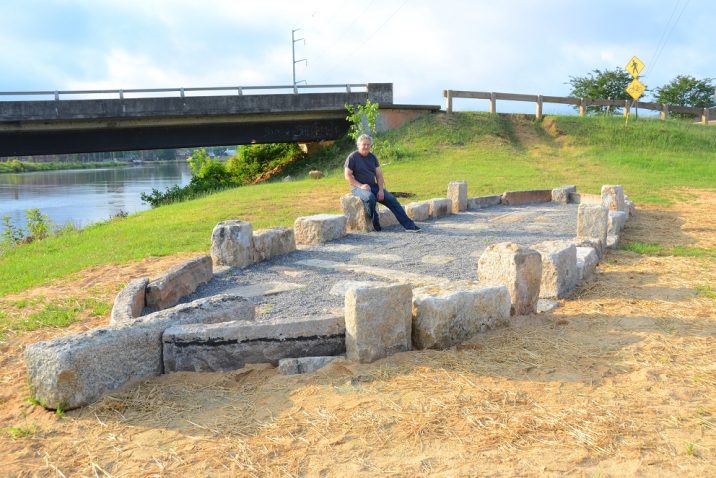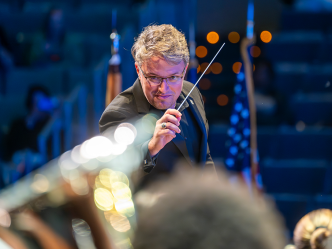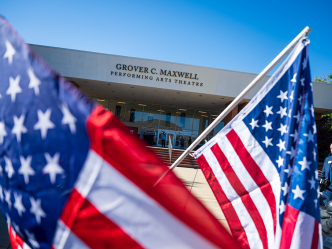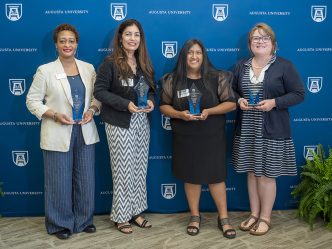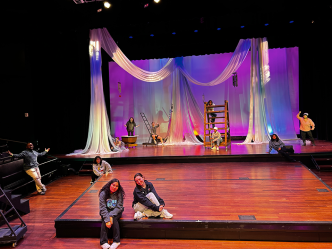Augusta University art professor Brian Rust has built a 50-foot-long sculpture made of granite stones inspired by the Petersburg boats
Ever since Augusta University art professor Brian Rust moved to the area more than 25 years ago, he has always enjoyed the trails along the Augusta Canal.
“I have run, biked and walked up and down this canal since 1991,” Rust said, standing by the Augusta Canal National Heritage Area’s Mill Village Trailhead near the Eve Street bridge. “I absolutely love this area, so when I heard there was going to be a proposal coming for public art along the canal, I was immediately interested.”
Last July, the Augusta Canal National Heritage Area announced it was seeking artists for a public art installation inspired by the setting and history of the Augusta Canal. The funding for the development of the artwork was a result of a 2018 grant from the Porter Fleming Foundation and the Augusta Canal National Heritage Area’s program funds from the National Park Service.
“The Augusta Canal Authority said it was basically looking for several things that were right up my alley,” said Rust, who is an artist known for his large-scale, site-specific sculptures throughout the country. “They wanted the public art to be community-based, permanent and interactive, if possible. They also said artists could use materials collected from the canal itself.”
Materials with history
When Rust learned he could use materials around the Augusta Canal, he immediately remembered seeing piles of old granite stones in several locations along the trails over the years.
“I had seen all of these big piles of stone around, but I didn’t know who owned them,” Rust said. “So I basically reached out to the canal authority ahead of time and I said, ‘I am going to make this proposal for the public art request, but I would like to use these stones. Is that OK?’ And they said, ‘Absolutely. We own those stones.’”
After learning that these granite curbstones once lined the streets of Augusta, Rust decided they would be the perfect material to use to develop a 50-foot-long rock sculpture on the banks of the Augusta Canal titled “Stone Boat.”
“I like working with materials that have a history to them,” Rust said. “And I like working with logs or stone or something that has some sort of other purpose, so this was perfect.”
Rust submitted a proposal of a stone sculpture that resembled the historic Petersburg boats that were once used as cargo vessels along the Augusta Canal to deliver cotton and farm goods. Two modern-day Petersburg boats are now used by the Augusta Canal National Heritage Area for guided tours along the canal.
After receiving more than two dozen submissions from local artists during the art call, the Augusta Canal Authority chose Rust’s boat concept.
“When we had the call for artists, we had almost 30-plus proposals,” said Rebecca Rogers, marketing director for the Augusta Canal National Heritage Area. “They were all great and it was really exciting to see that much interest. Then, we culled that down to six finalists.”
The six finalists then brought prototypes and sketches of their proposal to CanalFEST in November, so the public could comment on which proposed artwork they preferred, Rogers said.
“Ultimately, we picked Brian Rust’s piece for many reasons,” Rogers said. “Of course, we love that the ‘Stone Boat’ has a wonderful connection to the canal and it is inspired by our Petersburg boats. It also looks like it will be durable and something that people can interact with, not just by looking at it. People can walk around it, they can sit on it, they can relax and really take a moment to enjoy the lovely canal.”
The Augusta Canal Authority was also impressed by the fact that Rust has developed several site-specific sculptures in public areas throughout the country, including the Henry Lay Sculpture Park in Louisiana, Missouri; the South Carolina Botanical Garden in Clemson, South Carolina; Stone Quarry Hill Art Park in Cazenovia, New York; and the Mid-Columbia Arts Center in Kennewick, Washington.
“He has considerable experience in doing public art installations and, considering this is a first-time effort for us, I think it was a good idea to go with somebody who has demonstrated experience in this particular realm of art,” Rogers said. “This is helping our organization learn what’s involved in doing public art, with the idea of, this is not the last. This might be the first of many over the years that will be installed in different places and different styles along the canal.”
Made of stone
For the past several weeks, Rust has worked long hours creating “Stone Boat,” located at the Augusta Canal National Heritage Area’s Mill Village Trailhead near Eve Street bridge, just behind the Kroc Center on Broad Street.
“In some ways, creating this ‘Stone Boat’ is less like sculpture and more like landscape architecture,” Rust said. “There is very little carving that goes on with these stones, but there is a lot of picking and choosing and selecting just the right stones and deciding how these are going to look. I wanted it to feel like a Stonehenge or a ruins site. And I didn’t want it to be too regular. I wanted it to feel like as if the stones had been toppled over.”
The Augusta Canal National Heritage Area is hosting a public art unveiling event at the Eve Street site of “Stone Boat” at 11:30 a.m. Friday, May 31, to celebrate its completion. The event, which is open to the public, takes place the day before National Trails Day on June 1.
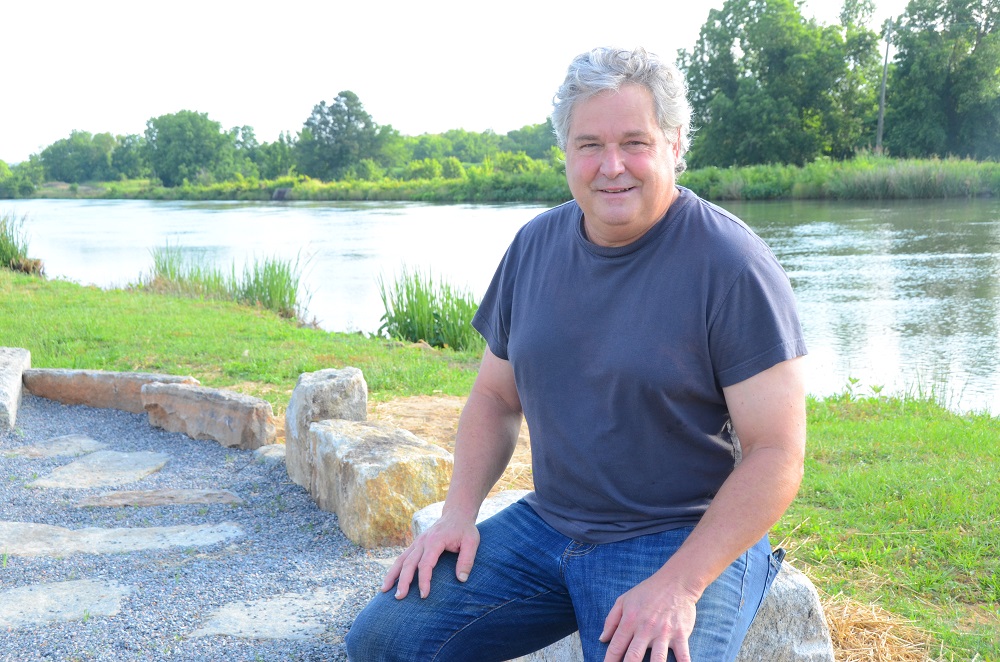
Now that “Stone Boat” is completed, Rust said he feels satisfied with the finished work and he hopes to see more public art along the canal in the future.
“Each one is a small thing, but collectively, these kinds of things start to give identity to different places,” Rust said. “Like, this spot by the canal will no longer just be the place behind the Kroc Center. Now, it becomes the place where the ‘Stone Boat’ is located. It becomes a marker and an identifier.”
While Rust was working to put “Stone Boat” together, he enjoyed people along the trail stopping and watching him work.
“Everybody who walked by, they saw it was a boat and they instantly knew it,” Rust said, standing next to his sculpture. “And I like pieces that have a physical imitation associated with them, so people can sit here on the stones and look out at the canal and enjoy the water.”
Rust also likes that the stones are sturdy enough that the entire family can enjoy the public art by the canal.
“I like things that are interactive and that are weaved into the community,” Rust said. “And with these granite stones, it’s hard to create these kinds of materials. They were used for different purposes, but now it’s public art.”
Teaching students about public art
Rust also felt it was important to invite some of his art students from Augusta University to be a part of the development of “Stone Boat,” so they could understand the process of building public art.
Senior sculpture major Nastassja Heim jumped at the opportunity to get some hands-on experience in the public art realm.
“I really wanted to get some experience doing larger art like this. I haven’t done much as far as installation and I definitely have not done any outdoor work before like this,” Heim said, holding a shovel she was using to lay some of the gravel stones. “I wanted to see some of that process and get involved in this. And I’m taking his sculptural installation class in the fall, so this is definitely relevant to that class.”
Rust explained that his sculptural installation class in Pamplin College of Arts, Humanities, and Social Sciences is different from other art classes because it deals with building art in a specific location.
“For example, the very first project next fall will be out in the Quad and I’ll have each one of my students build something using one of those gun niches,” Rust said, referring to the historic Augusta Arsenal area on the Summerville Campus. “They have to build something up in one of those niches or build something that incorporates one of those gun niches. And they can also tie into the physical history of the area, but they have to build something for that specific place.”
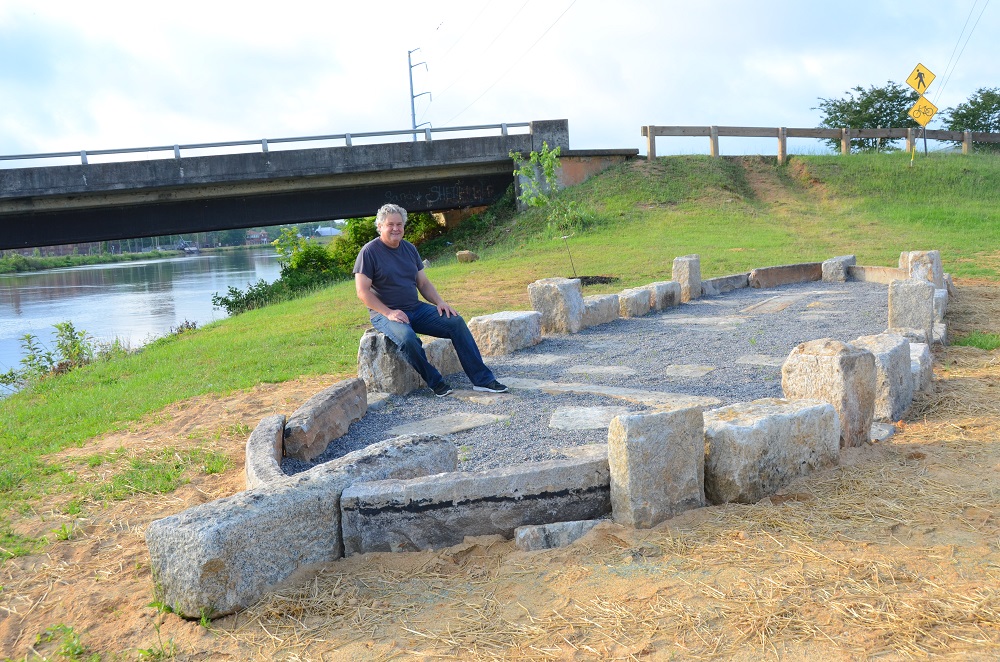
Those kinds of projects force students to think outside the box, Rust said.
“It’s very different than just building a piece in the studio,” he said. “You have to bring the piece up to the site, it has to stay there and it has to survive for a couple of weeks. So, during the class, we talk about the audience, interaction, safety and longevity of public art. We also answer questions like, how can you not go bankrupt but still have something that lasts several weeks out in Augusta’s weather? Weather, which we all know, is constantly changing.”
Heim said she can’t wait to take the sculptural installation class this fall because she really enjoyed helping work on Rust’s “Stone Boat” by the canal.
“Doing this kind of work opens up a lot of pathways for students,” Heim said. “They start seeing different opportunities and what’s possible and all the different sorts of art that you can do.”
Exposure to real-life opportunities in the field of art is something students will take with them after they graduate, Rust said.
“This is not rocket science. This is rock science,” Rust said, chuckling. “But it’s hard work and it’s being committed and it’s staying within your budget and meeting your deadline. And it’s about convincing people, ‘Yes. I can do this.’ And then figuring out a way to do it because every project is different.
“I mean, I’ve never done a project exactly like this before and I didn’t know exactly how to do it. But you just have to be committed and figure it out, step by step.”
 Augusta University
Augusta University
